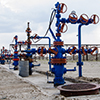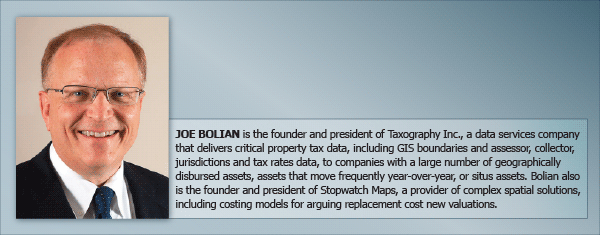
Property Tax Law
Operators Need Proactive Approach To Avoid Tax Bill Surprises
By Joe Bolian
ST. LOUIS–Oil and gas producers are perhaps the most heavily taxed companies in the United States. At a glance, these firms pay more than $670 billion annually in income, property, severance, sales, excise and other state and local taxes. According to 2013 state and local government financial data from the U.S. Census Bureau, property taxes accounted for 36.1 percent of that tax burden, Ernst & Young estimates.
Capital expansion over the past several years, in conjunction with the sudden drop in crude oil and natural gas prices, could increase audits and risks associated with misreporting assets for property tax purposes.
Understanding Regulations
With capital expansion, oil and gas operators will be tasked with reporting some business property assets for the first time this year. From the operator’s perspective, it is important he understands tax regulations in each state in which he has asserts, and considers how requirements differ from state to state or even county to county. The risks of reporting assets to the wrong jurisdiction range from basic fines, penalties and interest to lawsuits and perhaps bankruptcy.
In one 2013 case, three Canadian County, Ok., school districts found themselves scrambling to resolve budget issues after discovering business personal property taxes paid by several oil field companies had been allocated to incorrect school districts. The mistaken allocations had been going on for years, and Canadian County Assessor Matt Wehmuller says it might take a series of lawsuits to straighten things out. The financial impacts could be significant. Taxpayers in one district approved a $45 million bond issue in January 2013, with a modest levy increase expected. Responsibility for paying back those bonds now will be spread among fewer taxpayers, which means those tax costs will increase.
Larger oil companies already manage an average of 20 audits annually. These companies, as well as smaller producers, should anticipate an increase in audits in producing states because of the sudden drop in gas and oil prices that has counties and schools scrambling to hold up assessment values. With total state and local business property taxes accounting for 36.1 percent of total taxes, property tax data integrity now is more important than ever. To protect the company’s bottom line when it comes to property tax valuations, C-suite personnel should avoid failing to report fixed assets or referencing vintage tax rates for forecasting and accruals.
Reporting Assets
Timely and accurately reporting assets could be challenging under stringent and varying state and local reporting guidelines, especially when capital expansion is on the rise. Assets often are in rural areas, and typically a considerable amount of time is needed to research where those assets are taxable. Several states, such as Oklahoma, Colorado and Pennsylvania, also require tax reporting within school or special districts. This, paired with the possibility of taxing boundaries changing from year to year, greatly affects the time needed to ensure accurate reporting.
Even if a company’s property tax department has been reporting to the correct authorities and it is doing a diligent job, shifting boundaries mean it needs to verify how any changes impact its operations. One provider of tax boundary data to energy companies estimates that city boundaries change 25 percent year-over-year. City taxes are significantly higher than other taxing districts, leading to increased fines and penalties when errors are discovered.
Timely and accurately reporting can be difficult, which is why having an understanding of actual parcel boundaries could improve accuracy significantly. To avoid penalties, fines or back taxes, operators need to take a proactive approach to identifying asset locations for tax purposes. They also must rely on themselves, rather than the districts, to make these determinations, especially when an error could result in millions of dollars in fines and/or penalties. In aggressive states such as Louisiana, a property could be deemed “omitted.” Once discovered, that status could lead to several years of back taxes being imposed on a taxpayer.
Operators will need to be prepared to defend themselves in an audit as counties and schools scramble to keep values up, especially in leading audit states such as California.
Vintage Tax Rates
A combination of increased drilling activity over the past several years and the drop in commodity prices is burdening oil and gas companies with ensuring assessments are in line, while they produce timely and accurate property tax forecasts on both new and existing wells. Understanding state tax codes and filing requirements, paired with having access to up-to-date tax rates, will be crucial to compiling more timely and accurate budgets. This approach ultimately gains credibility with financial and accounting departments and eliminates surprises when reviewing the bottom line.
In states such as Kansas, Colorado, Wyoming and Arkansas, where assessments are based on prior year values, future assessments will be much higher than their current values. States such as Texas apply net present value adjustments to offset natural gas price decreases, so assessed values should decline. However, companies still will pay a significant amount of taxes in this state because of higher tax rates. Operators who are not already taking advantage of tax discounts in Texas may find the need to change processes and do so. Determining correct tax rates is crucial to paying in time to receive discounts and produce timely and accurate forecasts.
According to the American Petroleum Institute’s study, Oil & Natural Gas Transportation & Storage Infrastructure: Status, Trends, and Economic Benefits, capital expenditure levels have staying power even with investments declining. The study forecasts that by 2025, investment amounts will remain robust at $60 billion in the base case, and more than $80 billion in the high-production scenario.
The need to timely and accurately report assets and produce solid forecasts will be a priority for companies seeking to increase audit defenses in order to reduce property tax liabilities and avoid paying excessive penalties and fines.
For other great articles about exploration, drilling, completions and production, subscribe to The American Oil & Gas Reporter and bookmark www.aogr.com.















